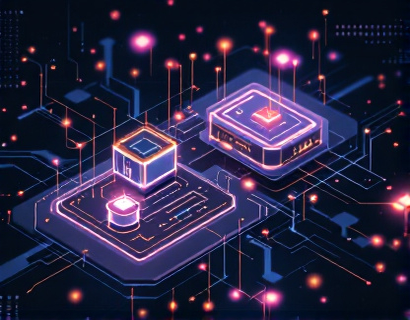Mastering Digital Currency Creation: A Guide to Cutting-Edge Software for Businesses and Blockchain Innovators
In the rapidly evolving landscape of digital finance, the ability to create and manage digital currencies has become an essential skill for businesses and blockchain innovators. This comprehensive guide delves into the advanced software tools designed to simplify the complex process of launching and managing digital tokens and currencies. By focusing on unparalleled customization, robust security, and seamless scalability, these tools make blockchain technology accessible and manageable for both novices and experts.
Understanding Digital Currency Creation
Digital currencies, often referred to as cryptocurrencies, are decentralized digital assets that use cryptography for security and operate on a distributed ledger technology known as blockchain. The creation of digital currencies involves several critical steps, including designing the token, setting up the blockchain, and deploying the currency into circulation. Each step requires a deep understanding of blockchain mechanics, smart contract programming, and security best practices.
Key Components of Digital Currency Creation
The process of creating a digital currency can be broken down into several key components:
- Token Design: This involves defining the purpose, functionality, and features of the digital currency. Deciding on the token's utility, such as whether it will be used for transactions, governance, or as a store of value, is crucial.
- Blockchain Selection: Choosing the right blockchain platform is vital. Popular options include Ethereum, Binance Smart Chain, and Solana, each offering different features and capabilities.
- Smart Contracts: These self-executing contracts with the terms directly written into code are essential for implementing the rules and functionalities of the digital currency.
- Security Measures: Ensuring the security of the digital currency is paramount. This includes implementing robust cryptographic techniques, conducting thorough audits, and following best practices to prevent vulnerabilities.
- Deployment and Distribution: Launching the digital currency involves deploying the smart contracts on the chosen blockchain and distributing the tokens to the intended holders.
Advanced Software Tools for Digital Currency Creation
To streamline the process of creating and managing digital currencies, advanced software tools have been developed. These tools provide a user-friendly interface, powerful features, and comprehensive support to cater to various needs:
Customization Options
One of the most significant advantages of using specialized software is the level of customization it offers. Users can tailor every aspect of their digital currency, from the token's name and symbol to the block time and reward structure. This flexibility ensures that the currency aligns perfectly with the project's goals and target audience.
For instance, the software allows users to define custom properties for their tokens, such as implementing a unique burning mechanism or setting up a dynamic supply model. This level of control is essential for creating a token that meets specific use cases and market demands.
Robust Security Features
Security is a top priority in digital currency creation. Advanced software tools incorporate multiple layers of security to protect the currency and its users. Key security features include:
- Cryptographic Algorithms: Utilizing state-of-the-art cryptographic techniques to ensure data integrity and confidentiality.
- Smart Contract Audits: Providing access to professional audits to identify and mitigate potential vulnerabilities in the smart contracts.
- Multi-Signature Wallets: Enabling secure transactions and management of funds through multi-signature wallets.
- Regular Updates and Patches: Ensuring the software is continuously updated to address new security threats and vulnerabilities.
Seamless Scalability
As digital currencies grow in popularity, the ability to scale efficiently is crucial. Advanced software tools are designed to handle increasing transaction volumes and user bases without compromising performance. Features that support scalability include:
- Sharding: Dividing the blockchain into smaller, manageable parts to improve processing speed and reduce congestion.
- Layer 2 Solutions: Implementing off-chain transactions to enhance throughput and reduce gas fees.
- Dynamic Adjustments: Automatically adjusting parameters such as block size and difficulty to maintain optimal network performance.
User-Friendly Interface
For both beginners and experienced developers, a user-friendly interface is essential. Advanced software tools provide intuitive dashboards and step-by-step guides to simplify the creation and management process. Key features of these interfaces include:
- Drag-and-Drop Functionality: Allowing users to easily configure settings and parameters without extensive coding knowledge.
- Real-Time Monitoring: Providing live insights into network performance, transaction history, and security metrics.
- Comprehensive Documentation: Offering detailed guides, tutorials, and FAQs to assist users at every stage of the process.
Benefits of Using Advanced Software for Digital Currency Creation
The use of advanced software tools for digital currency creation offers numerous benefits:
Firstly, it significantly reduces the barrier to entry for newcomers. With a user-friendly interface and comprehensive support, individuals without extensive blockchain knowledge can successfully create and manage their own digital currencies.
Secondly, the robust security features ensure that the currency is protected against common threats, building trust among users and stakeholders.
Thirdly, the scalability options enable the currency to grow and adapt to increasing demand, ensuring long-term viability and success.
Lastly, the customization options allow for the creation of unique and purpose-driven tokens, catering to specific market needs and enhancing the currency's value proposition.
Case Studies and Real-World Applications
To illustrate the practical applications and success stories of using advanced software for digital currency creation, consider the following examples:
Case Study 1: Decentralized Finance (DeFi) Token
A DeFi project aimed to create a token for use in lending and borrowing platforms. By utilizing advanced software, the team was able to:
- Design a token with built-in liquidity provisioning and staking mechanisms.
- Implement smart contracts that automatically execute lending and borrowing transactions.
- Ensure robust security through multiple audits and best practices.
The result was a highly functional and secure token that gained significant traction in the DeFi community, facilitating seamless financial operations.
Case Study 2: NFT Marketplace Token
An NFT marketplace decided to create a native token to reward creators and incentivize engagement. The software allowed them to:
- Define unique properties for the token, such as ownership and scarcity.
- Integrate the token with the marketplace's smart contracts for automated royalty payments.
- Implement a burn mechanism to control supply and maintain token value.
The token became a key component of the marketplace, driving user engagement and fostering a vibrant community of creators and collectors.
Future Trends in Digital Currency Creation
The landscape of digital currency creation is continually evolving, with several trends shaping the future:
Interoperability
As different blockchain networks emerge, the ability for tokens to interact across platforms becomes increasingly important. Advanced software is incorporating interoperability features, allowing tokens to be used seamlessly across various blockchains.
Sustainability
With growing concerns about the environmental impact of blockchain technology, sustainable solutions are gaining prominence. Software tools are being developed to support energy-efficient consensus mechanisms and carbon-neutral operations.
Regulatory Compliance
As governments around the world start to regulate digital currencies, compliance becomes a critical aspect of token creation. Advanced software is evolving to include features that help projects meet regulatory requirements and ensure legal compliance.
Conclusion
Mastering digital currency creation is no longer a task reserved for experts alone. With the advent of advanced software tools, businesses and blockchain innovators can confidently enter the digital finance realm. These tools provide unparalleled customization, robust security, and seamless scalability, making blockchain technology accessible and manageable for all. By leveraging these tools, creators can design, launch, and manage successful digital currencies that meet the demands of a rapidly changing market.










































